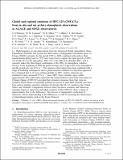Global and regional emissions of HFC-125 (CHF[subscript 2]CF[subscript 3]) from in situ and air archive atmospheric observations at AGAGE and SOGE observatories
Author(s)
O'Doherty, Simon; Cunnold, D. M.; Miller, Benjamin R.; Muhle, Jens; McCulloch, A.; Simmonds, P. G.; Manning, Alistair J.; Reimann, S.; Vollmer, M. K.; Greally, B. R.; Fraser, P. J.; Steele, L. P.; Krummel, P. B.; Dunse, B. L.; Porter, L. W.; Lunder, Chris R.; Schmidbauer, N.; Hermansen, Ove; Salameh, P. K.; Harth, C. M.; Wang, R. H. J.; Weiss, R. F.; Prinn, Ronald G; ... Show more Show less
DownloadPrinn_Global and.pdf (476.2Kb)
PUBLISHER_POLICY
Publisher Policy
Article is made available in accordance with the publisher's policy and may be subject to US copyright law. Please refer to the publisher's site for terms of use.
Terms of use
Metadata
Show full item recordAbstract
High-frequency, in situ observations from the Advanced Global Atmospheric Gases Experiment (AGAGE) and System for Observation of halogenated Greenhouse gases in Europe (SOGE) networks for the period 1998 to 2008, combined with archive flask measurements dating back to 1978, have been used to capture the rapid growth of HFC-125 (CHF[subscript 2]CF[subscript 3]) in the atmosphere. HFC-125 is the fifth most abundant HFC, and it currently makes the third largest contribution of the HFCs to atmospheric radiative forcing. At the beginning of 2008 the global average was 5.6 ppt in the lower troposphere and the growth rate was 16% yr[superscript −1]. The extensive observations have been combined with a range of modeling techniques to derive global emission estimates in a top-down approach. It is estimated that 21 kt were emitted globally in 2007, and the emissions are estimated to have increased 15% yr[superscript −1] since 2000. These estimates agree within approximately 20% with values reported to the United Nations Framework Convention on Climate Change (UNFCCC) provided that estimated emissions from East Asia are included. Observations of regionally polluted air masses at individual AGAGE sites have been used to produce emission estimates for Europe (the EU-15 countries), the United States, and Australia. Comparisons between these top-down estimates and bottom-up estimates based on reports by individual countries to the UNFCCC show a range of approximately four in the differences. This process of independent verification of emissions, and an understanding of the differences, is vital for assessing the effectiveness of international treaties, such as the Kyoto Protocol.
Date issued
2009-12Department
Massachusetts Institute of Technology. Center for Global Change Science; Massachusetts Institute of Technology. Department of Earth, Atmospheric, and Planetary SciencesJournal
Journal of Geophysical Research
Publisher
American Geophysical Union (AGU)
Citation
O’Doherty, S., D. M. Cunnold, B. R. Miller, J. Mühle, A. McCulloch, P. G. Simmonds, A. J. Manning, et al. “ Global and Regional Emissions of HFC-125 (CHF 2 CF 3 ) from in Situ and Air Archive Atmospheric Observations at AGAGE and SOGE Observatories .” Journal of Geophysical Research 114, no. D23 (2009). Copyright © 2009 the American Geophysical Union
Version: Final published version
ISSN
0148-0227